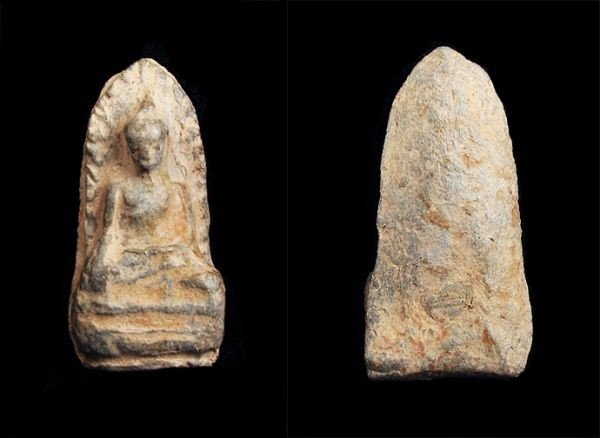Phra Rod Wat Mahawan
Phra Rod is the oldest amulet in Thailand, found at Wat Mahawan, Lampoon Province in Northern of Thailand. Made from clay and other sacred materials with mixed Buddhism style between Davarawadi and Sri Vichai in the middle age of Haripoonchai period (12nd century) B.E. 1223 (A.D. 680) date back over 1,300 years.
There are many memorandums of Haripoonchai City or Lampoon nowadays about the making of Phra Rod mentioned that the city was completely found by a group of hermits (Sudheva Lersi and Sukatakata Lersi) purely by the power of magic.
Once constructed the city, all hermits had to consider a suitable ruler for the city. Eventually, they concluded that Princess Chama Dhewi, the daughter of the King of Lawoh (Lopburi city) was the most suitable person to take over the throne. Therefore, they invited Princess Charma Dhevi from Lawa Pura to be the Queen of Haripoonchai City and thus, she became first ruler of the ancient city.
Phra Nang Chama Dhewi, the Queen who ruled the city state of Haripoonchai in the Northern of Thailand, had built 4 temples of good fortune to protect the land. In B.E. 1223 when Haripoonchai city was found, she invited 4 great hermits into the ceremony. The 4 hermits had created “Phra Sukaputtapatima” by each own and keep safe in 4 temples where located in North, South, West and East of Haripoonchai city for the purpose of expanding Buddha religion. “Phra Sukaputtapatima” comprises of 5 amulets: Phra Perm, Phra Bang, Phra Khong, Phra Liang and Phra Rod.
The four temples where located at 4 corners of town were found by Queen Phra Nang Chama Dhewi are:
1. Wat Donkaew in East side. In B.E.2484-2485 people found Phra Perm, Phra Bang, Phra Khong, Phra Liang, etc. All amulets were found in exception of Phra Rod.
2. Wat PhraKhong in North side, later called Wat PhraKhongLersi
3. Wat Mahawan in West side, Phra Rod amulets were found here.
4. Wat Pratoolee in South side which was used as the route to escape enemies in war time as “Phratoolee” mean door for escape.
These 4 temples have all of Lumpoon province amulets and have been found at later time. The 4 hermits had kept their amulets in Wat Donkaew, Wat PhraKhong, Wat Mahawan, Wat Pratoolee. These amulets are beautiful arts of Haripoonchai.
“Phra Rod” was from hermit’s name “Narata Lersi” and changed to “NaRod” in later time. Once people found the amulets at Wat Mahawan, they started to call “Phra Rod”.
Legend said that Sudheva Lersi and Sukatakata Lersi had met with 108 hermits in the ceremony to create Haripoonchai’s amulets by bringing sacred clay from 4 different land, 108 herbs and flowers. All sacred material were mixed and pressed into molds, then chanted with spell by 108 hermits.
There are 5 pim (mold type) Pim Yai, Pim Klang, Pim Lek, Pim Tuean and Pim Tor. Phra Rod is one of most famous oldest amulets in the set of Benjapakee. Amulets were made by the craftman of Haripoonchai in the own arts style bearing particularly unique beauty.
Reason for Phra Rod Creation
The purpose of Phra Rod creation was to be tradition of the king and religious renewal and strengthening prosperity. However, giving the amulets to the military was to be mental restraint tool because in those past days the country was always invaded by the enemies.
Discovering of Phra Rod
Phra Rod was found in the first time in earlier period of King Rama V but the memorandum of a monk named “Tha”, the head of Wat Kong Lersi in that time and from the monk named “Boontham” of Wat Phrathat Haripoonchai mentioned that in 2435 (1892) Chedi of Wat Mahawan was ruined and some part collapsed. The Chedi was rebuilt so the amulets were found inside. Some of these amulets were again refilled back into the Chedi.
In 2451 (1908), the base of Chedi Wat Mahawan was ruined and found amulets which were refilled in 2435 (1892). All of these amulets were brought out. These amulets were found in large quantity and recognized to be amulet from old Chedi which succeed till now.
Also newly made of Phra Rod amulets to replace the old period amulets in Chedi, expected that made by Khruba Krongkaew which different period from the amulets in first found.
Until in 2498 (1955), the amulets were found again by digging in the temple area and under the priest’s bode. These founds were recognized amulets from new lot which available nowadays. Then in 2506 (1963), in renovation of the chapel is the last time of finding Phra Rod amulets about 300 pieces. Eversince people oftenly dug to find amulet in the temple area but rare. Nowadays, digging was forbidden.
Phra Rod made from baked clay which seen in several colors due to difference of temperature used to bake the amulets (low to high) white, yellow, orange brick, red, green, brown and black. Phra Rod is beautiful in Buddhism arts, high value and good in warding-off harms. Thai people regard this particular amulet as Buddha of success in escaping, protection and being safe from all dangers and disasters or misfortunes.
Notification points of Phra Rod Wat Mahawan in term of content texture
• Phra Rod is very old with the age over 1,300 years, made from baked clay which were buried in the ground for a long time until become solid as a rock.
• Surface skin is wrinkle and dry-out which looks like the oldie’s skin. Content texture is fine-grained and smooth since amulet made from filter clay. Neither sand nor gravel is appeared.
• Lines pattern on image body looks sharp, clear and deep.
• From content analysis, Phra Rod made from sacred ground stone powders, other sacred powders, 108 herbs and flowers, filter clay as cement substance. Pressing into the mould, to be dried then, baked with highest temperature until stone powder was melted and welded in the same mixture with filter clay. This methodology made amulets being tough and durable in thousand years.
• Faked amulet is made from Rasin or emulsion pressed into 2 layers for inside and outside, baked in mild temperature then, chemically decorated or buried in the ground in order to make dust or soil covering on the surface which imitates the old stain. Anyway, dead spots of faked amulet for self-checking e.g., surface skin looks tight and oily, soil stain is unsystematically scattered throughout image body and could be easily removed out by finger or end of nail or washing, then reveal the real tight surface.
Moulds of Phra Rod, Wat Mahawan
Phra Rod amulets were classified into 5 moulds:- Pim Yai (big), Pim Klang (middle), Pim Lek(small), Pim Tor(short) and Pim Tuane (shallow).
1. Phra Rod Wat Mahanwan: Pim Yai (Big mould)
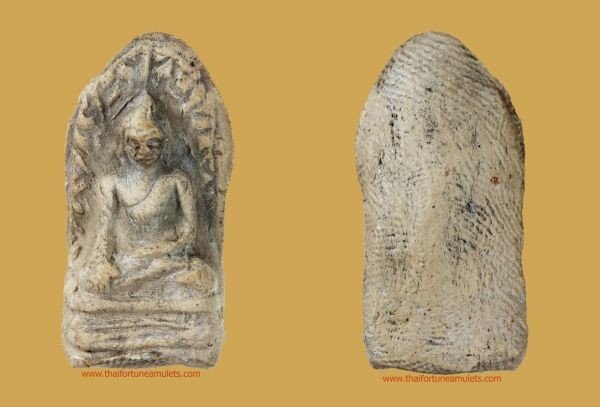 Notification points of Phra Rod Pim Yai (Big mould) in term of moulds
Notification points of Phra Rod Pim Yai (Big mould) in term of moulds
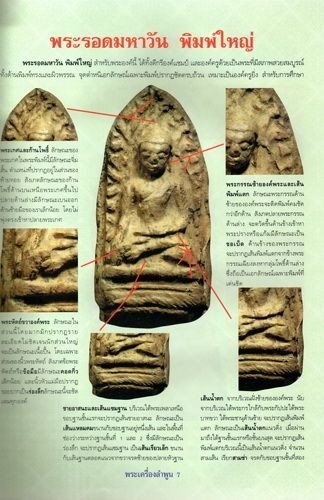 1. Head stem and Bodhi leaves: Head stem is short. When looking at Bodhi stem at the top above head, the bottom of leave line is slightly deviated to right hand side of image body, not vertically straight line. 2. Right hand side of image body which is not clearly seen in details. Fingers are slightly compressed, the thumb has clearly marking in depth nook. 3. Seat and inserted line at base: Sharp line is appeared between lap and going parallel with edge of first tier. Another line, in area of gap between first and second tier, it appeared inserted small sharp line going along with base line (second tier) from right to left. 4. Left ear and broken line: Left ear is clearer seen than right ear. At end of left ear, appeared line like a hook crashing to left cheek. For beside of left ear at top, it appeared broken sharp line dragging down in diagonal to group of Bodhi leaves in below. This is unique specially appeared for Pim Yai (big mould) 5. Waterfall line: At left side of image body, between under left hand, under right foot and under left knee which appeared 3 vertically waterfall lines in three parts. (from under left hand meet to the second tier)2. Phra Rod Wat Mahawan: Pim Klang (Middle mould)
1. Head stem and Bodhi leaves: Head stem is short. When looking at Bodhi stem at the top above head, the bottom of leave line is slightly deviated to right hand side of image body, not vertically straight line. 2. Right hand side of image body which is not clearly seen in details. Fingers are slightly compressed, the thumb has clearly marking in depth nook. 3. Seat and inserted line at base: Sharp line is appeared between lap and going parallel with edge of first tier. Another line, in area of gap between first and second tier, it appeared inserted small sharp line going along with base line (second tier) from right to left. 4. Left ear and broken line: Left ear is clearer seen than right ear. At end of left ear, appeared line like a hook crashing to left cheek. For beside of left ear at top, it appeared broken sharp line dragging down in diagonal to group of Bodhi leaves in below. This is unique specially appeared for Pim Yai (big mould) 5. Waterfall line: At left side of image body, between under left hand, under right foot and under left knee which appeared 3 vertically waterfall lines in three parts. (from under left hand meet to the second tier)2. Phra Rod Wat Mahawan: Pim Klang (Middle mould) 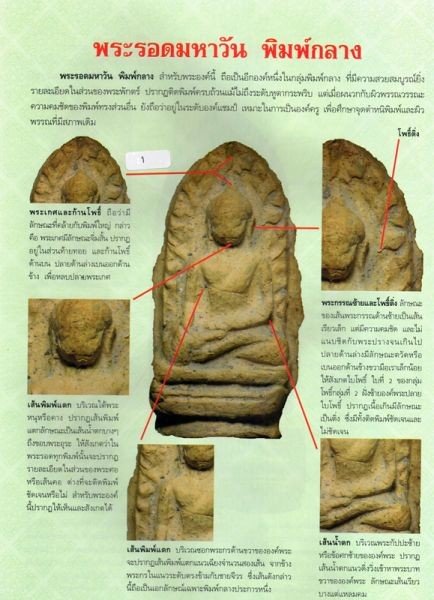 3. Phra Rod Wat Mahawan: Pim Lek (small mould)
3. Phra Rod Wat Mahawan: Pim Lek (small mould) 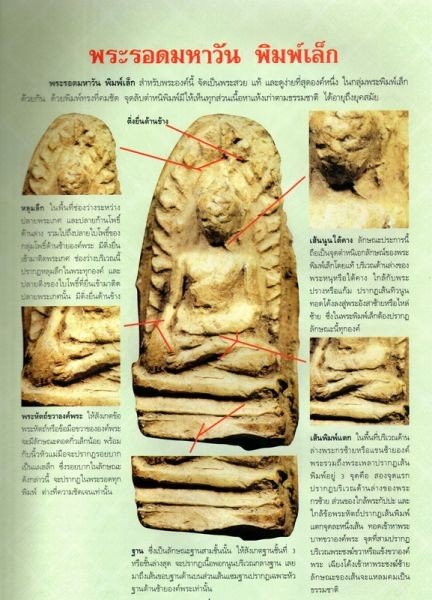 4. Phra Rod Wat Mahawan: Pim Tor (short mould)
4. Phra Rod Wat Mahawan: Pim Tor (short mould) 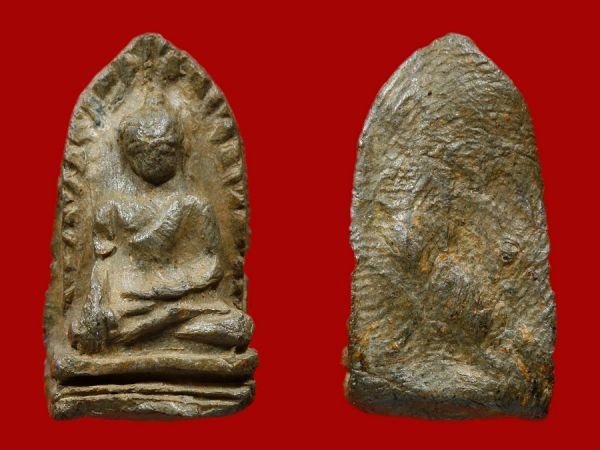
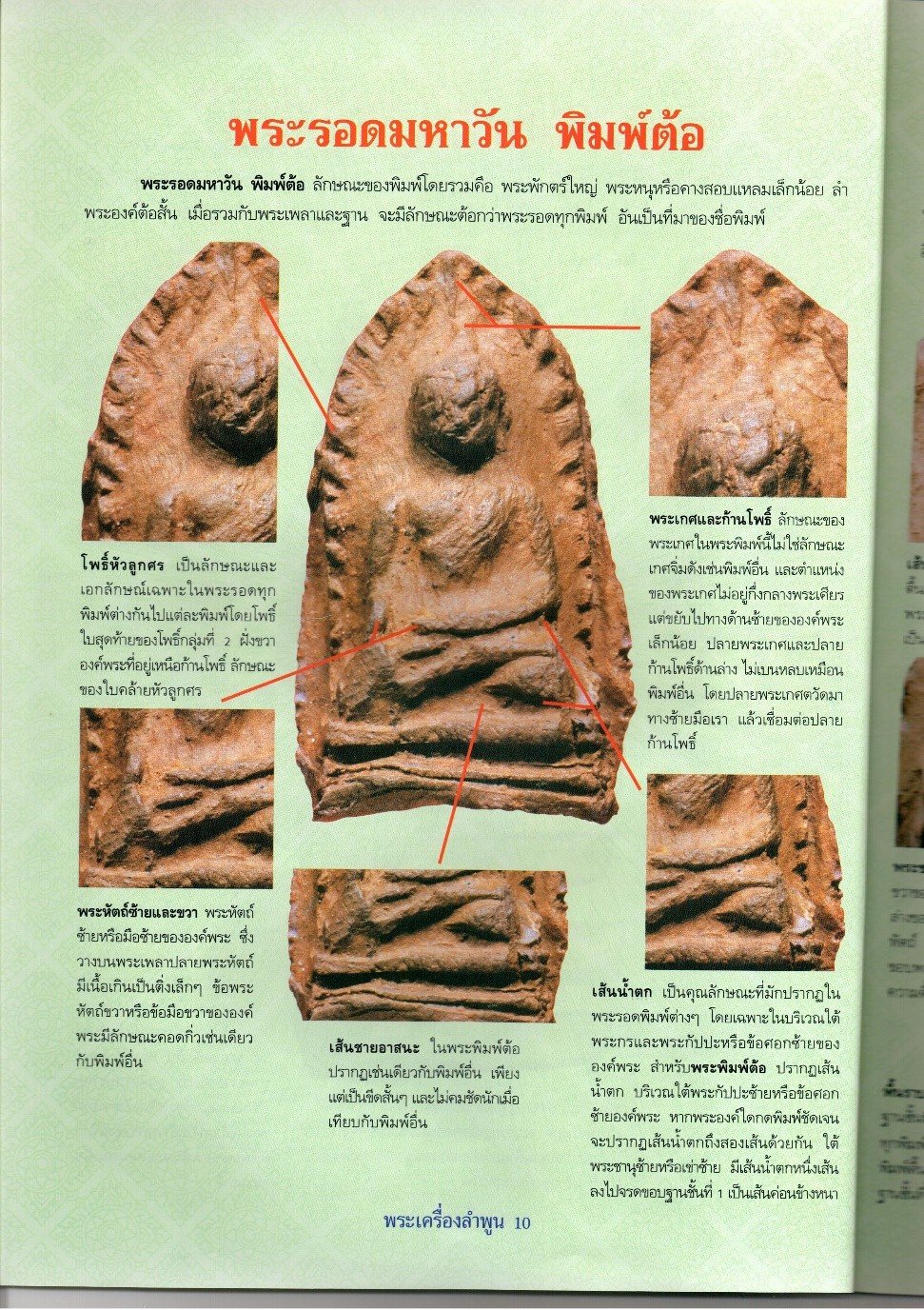
5. Phra Rod Wat Mahawan: Pim Tuean (shallow mould)
